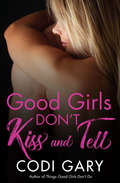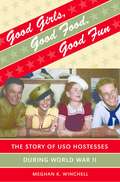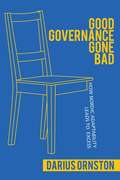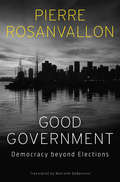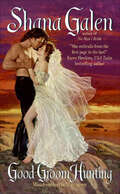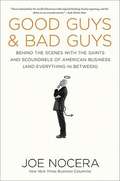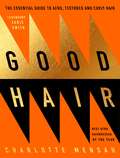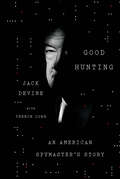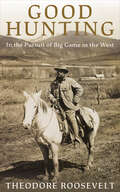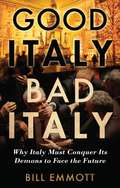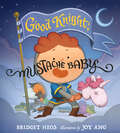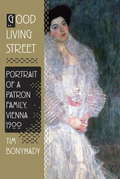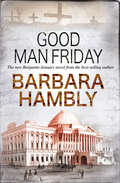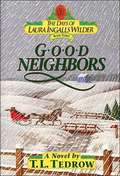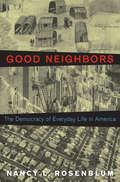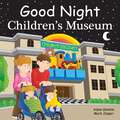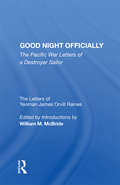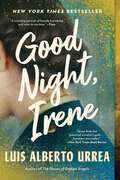- Table View
- List View
Good Girls Don't Kiss and Tell (Rock Canyon, Idaho #7)
by Codi GaryThey used to be enemies… Gracie McAllister has never been the relationship type…until now. After a brutal visit from her happily married parents, Gracie is looking for Mr. Right…not Mr. Right Now. And despite their recent truce, there is no way sexy Eric Henderson is anything but. Now they’re allies… Eric has always had a thing for Gracie, but they could never manage to get on the same page long enough to explore the heat between them. When Eric gets the opportunity of a lifetime, he asks Gracie for help…and swears her to secrecy. But is that all? Now the whole town thinks their romance is real, but it’s just a business arrangement. There’s no way they’re actually falling in love…right? “Sassy, sexy and sweet…Codi never disappoints!” –New York Times bestselling author Monica Murphy
Good Girls, Good Food, Good Fun
by Meghan K. WinchellThroughout World War II, when Saturday nights came around, servicemen and hostesses happily forgot the war for a little while as they danced together in USO clubs, which served as havens of stability in a time of social, moral, and geographic upheaval. Meghan Winchell demonstrates that in addition to boosting soldier morale, the USO acted as an architect of the gender roles and sexual codes that shaped the "greatest generation."Combining archival research with extensive firsthand accounts from among the hundreds of thousands of female USO volunteers, Winchell shows how the organization both reflected and shaped 1940s American society at large. The USO had hoped that respectable feminine companionship would limit venereal disease rates in the military. To that end, Winchell explains, USO recruitment practices characterized white middle-class women as sexually respectable, thus implying that the sexual behavior of working-class women and women of color was suspicious. In response, women of color sought to redefine the USO's definition of beauty and respectability, challenging the USO's vision of a home front that was free of racial, gender, and sexual conflict.Despite clashes over class and racial ideologies of sex and respectability, Winchell finds that most hostesses benefited from the USO's chaste image. In exploring the USO's treatment of female volunteers, Winchell not only brings the hostesses' stories to light but also supplies a crucial missing piece for understanding the complex ways in which the war both destabilized and restored certain versions of social order.
Good Governance Gone Bad: How Nordic Adaptability Leads to Excess (Cornell Studies in Political Economy)
by Darius OrnstonIf we believe that the small, open economies of Nordic Europe are paragons of good governance, why are they so prone to economic crisis? In Good Governance Gone Bad, Darius Ornston provides evidence that adapting flexibly to rapid, technological change and shifting patterns of economic competition may be a great virtue, but it does not prevent countries from making strikingly poor policy choices and suffering devastating results. Home to three of the "big five" financial crises in the twentieth century, Nordic Europe in the new millennium has witnessed a housing bubble in Denmark, the collapse of the Finnish ICT industry, and the Icelandic financial crisis.Ornston argues that the reason for these two seemingly contradictory phenomena is one and the same. The dense, cohesive relationships that enable these countries to respond to crisis with radical reform render them vulnerable to policy overshooting and overinvestment. Good Governance Gone Bad tests this argument by examining the rise and decline of heavy industry in postwar Sweden, the emergence and disruption of the Finnish ICT industry, and Iceland’s impressive but short-lived reign as a financial powerhouse as well as ten similar and contrasting cases across Europe and North America. Ornston demonstrates how small and large states alike can learn from the Nordic experience, providing a valuable corrective to uncritical praise for the "Nordic model."
Good Government: Democracy beyond Elections
by Pierre RosanvallonFew would disagree that Western democracies are experiencing a crisis of representation. In the United States, gerrymandering and concentrated political geographies have placed the Congress and state legislatures in a stranglehold that is often at odds with public opinion. Campaign financing ensures that only the affluent have voice in legislation. Europeans, meanwhile, increasingly see the European Union as an anti-democratic body whose “diktats” have no basis in popular rule. The response, however, has not been an effective pursuit of better representation. In Good Government, Pierre Rosanvallon examines the long history of the alternative to which the public has gravitated: the empowered executive. Rosanvallon argues that, faced with everyday ineptitude in governance, people become attracted to strong leaders and bold executive action. If these fail, they too often want even stronger personal leadership. Whereas nineteenth-century liberals and reformers longed for parliamentary sovereignty, nowadays few contest the “imperial presidency.” Rosanvallon traces this history from the Weimar Republic to Charles De Gaulle’s “exceptional” presidency to the Bush-Cheney concentration of executive power. Europeans rebelling against the technocratic EU and Americans fed up with the “administrative state” have turned to charismatic figures, from Donald Trump to Viktor Orbán, who tout personal strength as their greatest asset. This is not just a right-wing phenomenon, though, as liberal contentment with Obama’s drone war demonstrates. Rosanvallon makes clear that contemporary “presidentialism” may reflect the particular concerns of the moment, but its many precursors demonstrate that democracy has always struggled with tension between popular government and concentrated authority.
Good Groom Hunting (Misadventures In Matrimony Ser. #2)
by Shana GalenOn the trail of fortune . . . Adventurous Josephine Hale is determined to live up to her scandalous heritage. With half of a crumbling treasure map that belonged to her grandfather, the legendary pirate, in her possession, the bold and beautiful lady is half-way to a fortune. Unfortunately, the remainder of the map belongs to Stephen Doubleday, Earl of Westman, her family's sworn enemy--and Josie will do anything to get her hands on it . . . even if it means seducing the handsome rogue.And a passion beyond dreamsUtterly destitute, Stephen never dreamed a fairy tale about pirate's treasure would turn out to be true--bringing him a possible fortune and a passionate lover. But will joining in this wild, impetuous beauty's perilous undertaking be the biggest mistake of his life? Or will it lead Stephen and Josie to a treasure far more precious than pirate gold--a fiery and forever love?
Good Guys and Bad Guys
by Joe NoceraWhat's it like to be a top tobacco executive when your kid asks you about smoking? How did a young liberal arts major become the hottest tech-stock analyst of the '90s, and why did he self-destruct? How did one family's dysfunction change the media landscape? Some people think business journalism is all about balance sheets, income statements, and earnings per share. But if you want to answer the really interesting questions-about heroes and hucksters, visionaries and madmen, and other larger-than-life characters-you need a reporter like Joe Nocera. For more than twenty-five years Nocera has shed new light on the giants of the business world-Warren Buffett, T. Boone Pickens, Bob Nardelli-as well as on the less famous but equally fascinating. He builds stories around their motivations, personalities, and deepest characters. And instead of just pigeonholing them as good guys or bad guys, he explores the gray areas in between.
Good Guys and Bad Guys
by Joe NoceraThe greatest columns and profiles by the bestselling coauthor of All the Devils Are Here. What's it like to be a top tobacco executive when your kid asks you about smoking? How did a young liberal arts major become the hottest tech-stock analyst of the '90s, and why did he self-destruct? How did one family's dysfunction change the media landscape?Some people think business journalism is all about balance sheets, income statements, and earnings per share. But if you want to answer the really interesting questions-about heroes and hucksters, visionaries and madmen, and other larger-than-life characters-you need a reporter like Joe Nocera.For more than twenty-five years Nocera has shed new light on the giants of the business world-Warren Buffett, T. Boone Pickens, Bob Nardelli-as well as on the less famous but equally fascinating. He builds stories around their motivations, personalities, and deepest characters. And instead of just pigeonholing them as good guys or bad guys, he explores the gray areas in between.
Good Hair: The Essential Guide to Afro, Textured and Curly Hair
by Charlotte MensahA celebration of the unique beauty of Black hair, this book is packed with expert advice, top maintenance tips!'Legendary' Zadie Smith'Charlotte is not only the most influential expert on black hair, but an inspiring entrepreneur whose Notting Hill salon is part beauty destination, part cultural hub with its cross-section of powerful, dynamic clients' Kenya Hunt, Fashion Editor at Grazia___________________Featuring case studies of clients who came to her looking for a hair fix, Good Hair dispels common hair myths and give you the knowledge and tools to attain good hair health. Charlotte's expertise is second-to-none and her advice acts as a corrective to the conflicting and misguided advice that can be found online.Packed with expert advice, nourishing recipes and top maintenance tips, Good Hair is a celebration of the unique beauty of Black hair. It is the ultimate guide on how to:· Identify and understand your curl textures· Promote hair growth and find good products· Choose the right protective styles· Overcome hair loss, itchiness and dryness· Try styles such as cornrows, locs and bantu knotsAnd while Good Hair is the long over-due bible and how to guide for black hair, this is not just a hairstyling book. It is also a very well-documented account of the cultural and political history of black hair as well as an inspirational memoir of hope, determination and entrepreneurialism, as we follow Charlotte's journey from Ghana to opening her first hair salon in West London.'This book is not just a brilliant insight into exactly how she became such a powerhouse, it is also an excellent guide to everything you need to know about black hair' Funmi Fetto, author of Palette and contributing editor at British Vogue
Good Hunting: An American Spymaster's Story
by Vernon Loeb Jack Devine"A sophisticated, deeply informed account of real life in the real CIA that adds immeasurably to the public understanding of the espionage culture—the good and the bad." —Bob WoodwardJack Devine ran Charlie Wilson's War in Afghanistan. It was the largest covert action of the Cold War, and it was Devine who put the brand-new Stinger missile into the hands of the mujahideen during their war with the Soviets, paving the way to a decisive victory against the Russians. He also pushed the CIA's effort to run down the narcotics trafficker Pablo Escobar in Colombia. He tried to warn the director of central intelligence, George Tenet, that there was a bullet coming from Iraq with his name on it. He was in Chile when Allende fell, and he had too much to do with Iran-Contra for his own taste, though he tried to stop it. And he tangled with Rick Ames, the KGB spy inside the CIA, and hunted Robert Hanssen, the mole in the FBI.Good Hunting: An American Spymaster's Story is the spellbinding memoir of Devine's time in the Central Intelligence Agency, where he served for more than thirty years, rising to become the acting deputy director of operations, responsible for all of the CIA's spying operations. This is a story of intrigue and high-stakes maneuvering, all the more gripping when the fate of our geopolitical order hangs in the balance. But this book also sounds a warning to our nation's decision makers: covert operations, not costly and devastating full-scale interventions, are the best safeguard of America's interests worldwide. Part memoir, part historical redress, Good Hunting debunks outright some of the myths surrounding the Agency and cautions against its misuses. Beneath the exotic allure—living abroad with his wife and six children, running operations in seven countries, and serving successive presidents from Nixon to Clinton—this is a realist, gimlet-eyed account of the Agency. Now, as Devine sees it, the CIA is trapped within a larger bureaucracy, losing swaths of turf to the military, and, most ominous of all, is becoming overly weighted toward paramilitary operations after a decade of war. Its capacity to do what it does best—spying and covert action—has been seriously degraded. Good Hunting sheds light on some of the CIA's deepest secrets and spans an illustrious tenure—and never before has an acting deputy director of operations come forth with such an account. With the historical acumen of Steve Coll's Ghost Wars and gripping scenarios that evoke the novels of John le Carré even as they hew closely to the facts on the ground, Devine offers a master class in spycraft.
Good Hunting: In Pursuit of Big Game in the West
by Theodore RooseveltStep into the rugged wilderness of the American West with one of history's most iconic figures, Theodore Roosevelt, in his thrilling and insightful book, Good Hunting: In Pursuit of Big Game in the West. This classic work offers readers a firsthand account of Roosevelt's adventures as a hunter, conservationist, and naturalist, capturing the essence of the wild frontier and the majesty of its big game.
Good Italy, Bad Italy
by Bill EmmottNot long ago Italy was Europe's highly touted emerging economy, a society that blended dynamism and super-fast growth with a lifestyle that was the envy of all. Now it is viewed as a major threat to the future of the Euro, indeed to the European Union as a whole. Italy's political system is shorn of credibility as it struggles to deal with huge public debts and anemic levels of economic growth. Young people are emigrating in droves, frustrated at the lack of opportunity, while older people stubbornly cling to their rights and privileges, fearful of an uncertain future. In this lively, up-to-the-minute book, Bill Emmott explains how Italy sank to this low point, how Italians feel about it, and what can be done to return the country to more prosperous and more democratic times. With the aid of numerous personal interviews, Emmott analyzes "Bad Italy"—the land of disgraced Prime Minister Silvio Berlusconi, an inadequate justice system, an economy dominated by special interests and continuing corruption—against its contrasting foil "Good Italy"—the home of enthusiastic entrepreneurs, truth-seeking journalists, and countless citizens determined to end mafia domination for good.
Good Judgment: Making Judicial Decisions
by Robert SharpeGood Judgment, based upon the author's experience as a lawyer, law professor, and judge, explores the role of the judge and the art of judging. Engaging with the American, English, and Commonwealth literature on the role of the judge in the common law tradition, Good Judgment addresses the following questions: What exactly do judges do? What is properly within their role and what falls outside? How do judges approach their decision-making task? In an attempt to explain and reconcile two fundamental features of judging, namely judicial choice and judicial discipline, this book explores the nature and extent of judicial choice in the common law legal tradition and the structural features of that tradition that control and constrain that element of choice. As Sharpe explains, the law does not always provide clear answers, and judges are often left with difficult choices to make, but the power of judicial choice is disciplined and constrained and judges are not free to decide cases according to their own personal sense of justice. Although Good Judgment is accessibly written to appeal to the non-specialist reader with an interest in the judicial process, it also tackles fundamental issues about the nature of law and the role of the judge and will be of particular interest to lawyers, judges, law students, and legal academics.
Good Knight, Mustache Baby (Mustache Baby)
by Bridget HeosEveryone&’s favorite baby-with-a-mustache dons shining armor in hopes of staving off sleep in this hilarious bedtime book.Knights in shining armor go full baby (and full mustache) in this silly and soothing bedtime adventure. Young knaves will fall blissfully asleep after hearing the tale of two brave knights: Baby Billy, House of Mustache, and Baby Javier, House of Beard, and how they fought to conquer their biggest foe: bedtime! The babies fight their enemy valiantly, but eventually even gallant Baby Billy falls victim to sleep, foiled by, of all things, an enchanted book. Though Billy succumbs to the magic of the story, in his dreams, he rejoins his bearded co-knigh . . . and they became the stuff of legend.
Good Living Street
by Tim BonyhadyVienna and its Secessionist movement at the turn of the last century is the focus of this extraordinary social portrait told through an eminent Viennese family, headed by Hermine and Moriz Gallia, who were among the great patrons of early-twentieth-century Viennese culture at its peak. Good Living Street takes us from the Gallias' middle-class prosperity in the provinces of central Europe to their arrival in Vienna, following the provision of Emperor Franz Joseph in 1848 that gave Jews freedom of movement and residence, legalized their religious services, opened public service and professions up to them, and allowed them to marry. The Gallias, like so many hundreds of thousands of others, came from across the Hapsburg Empire to Vienna, and for the next two decades the city that became theirs was Europe's center of art, music, and ideas. The Gallias lived beyond the Ringstrasse in Vienna's Fourth District on the Wohllebengasse (translation: Good Living Street), named after Vienna's first nineteenth-century mayor. In this extraordinary book we see the amassing of the Gallias' rarefied collections of art and design; their cosmopolitan society; we see their religious life and their efforts to circumvent the city's rampant anti-Semitism by the family's conversion to Catholicism along with other prominent intellectual Jews, among them Gustav Mahler. While conversion did not free Jews from anti-Semitism, it allowed them to secure positions otherwise barred to them. Two decades later, as Kristallnacht raged and Vienna burned, the Gallias were having movers pack up the contents of their extraordinary apartment designed by Josef Hoffmann. The family successfully fled to Australia, bringing with them the best private collection of art and design to escape Nazi Austria; included were paintings, furniture, three sets of silver cutlery, chandeliers, letters, diaries, books and bookcases, furs--chinchilla, sable, sealskin--and even two pianos, one upright and one Steinway. Not since the publication of Carl Schorske's acclaimed portrait of Viennese modernism, Fin-de-Siècle Vienna, has a book so brilliantly--and completely--given us this kind of close-up look at turn-of-the-last-century Viennese culture, art, and daily life--when the Hapsburg Empire was fading and modernism and a new order were coming to the fore. Good Living Street re-creates its world, atmosphere, people, energy, and spirit, and brings it all to vivid life.From the Hardcover edition.
Good Man Friday (The Benjamin January Novels #12)
by Barbara HamblyFree man of color Benjamin January travels to Washington, DC, to track down a missing mathematician in this &“excellent&” pre–Civil War mystery (Publishers Weekly, starred review). New Orleans, 1838. Living in antebellum New Orleans as a free man of color, Benjamin January has always taken whatever work he could find. But when he suddenly loses his job playing piano at extravagant parties, he finds himself taking on an entirely new—and exceedingly dangerous—enterprise. Sugar planter Henri Viellard has hired Benjamin to travel with him to Washington, DC. Henri&’s friend, an elderly English mathematician named Selwyn Singletary, was last seen in Washington before he went missing. With Benjamin&’s help, Henri intends to track him down. Plunged into a murky world of spies, slave snatchers, and dirty politicians, Benjamin uncovers a coded secret that he attempts to decipher with the help of a young Edgar Allan Poe. But a powerful ring of conspirators doesn&’t want the secret known. And they&’re ready to kill anyone who gets in their way.
Good Morning Comrades
by Stephen Henighan OndjakiThe first publication in English by one of the most talented, prolific and celebrated novelists in Africa, Ondjaki's Good Morning Comrades looks at the calm before the storm of the Angolan Civil War from the perspective of a young boy. Translated from the Portuguese.
Good Morning, Mr. Zip Zip Zip: Movies, Memory, and World War II
by Richard SchickelIn this memoir, film critic Schickel recalls his childhood days growing up in a Milwaukee suburb during World War II. The story centers around the author's lifelong love of the movies. Schickel also discusses the ways in which the wartime movies he enjoyed as a youth misled the public about the nature of the war, our soldiers, our government, and the home front. Annotation ©2004 Book News, Inc., Portland, OR (booknews.com)
Good Neighbor Diplomacy: United States Policies in Latin America, 1933-1945 (The Johns Hopkins University Studies in Historical and Political Science)
by Irwin GellmanOriginally published in 1979. American diplomacy during Franklin D. Roosevelt's presidency has received much attention, with one notable exception—the United States' relations with Latin America. Irwin Gellman's book corrects this past neglect through a perceptive analysis of FDR's "Good Neighbor" efforts in Latin America. Based on a fresh examination of State Department records and extensive manuscript sources (including an unprecedented use of Nelson Rockefeller's oral history archives), the book points out the complexities of Good Neighbor diplomacy and its intimate relationship to Roosevelt's global strategies. As background to his discussions of FDR's policies, Gellman looks first at how Latin American affairs were handled during the administrations of Harding, Coolidge, and Hoover, the three Republicans who preceded Roosevelt in office. Good Neighbor diplomacy, Gellman shows, was not a carryover from these administrations; it bore the distinctive mark of FDR's own making. He then describes how Roosevelt's policy of nonintervention worked, particularly how military force was superseded by more subtle diplomatic maneuverings. Turning to a discussion of economic relations with Latin America, Gellman focuses on how the United States' own situation—cut off from international trade by the Depression—encouraged regional expansion. And, finally, he looks at how Roosevelt parlayed the threat of war in Europe and the specter of Nazi penetration in the Americas to further solidify a hemispheric stand. Gellman's account vividly demonstrates that Good Neighbor diplomacy was as much the product of personality as it was of policy. In particular, it emerged out of the rivalries and alliances among three men: Roosevelt; his Secretary of State, Cordell Hull; and Assistant Secretary of State, Sumner Welles. Gellman (the first to have access to FBI files on Welles) characterizes FDR as an astute politician who saw an opportunity to use pan-Americanism to restore America to world prominence—yet could not handle the personality conflicts among those in his own ranks. Gellman shows how tenuous a government policy can be when so much of it depends on personal control and influence.
Good Neighbors (The Days of Laura Ingalls Wilder, Book #3)
by T. L. TedrowFood provisions are scarce as the little town of Mansfield faces one of the worst winters on record. Fierce blizzards isolate the town from the rest of the world. Laura and Manly spearhead a heroic relief effort for their starving neighbors.
Good Neighbors: The Democracy of Everyday Life in America
by Nancy L. Rosenblum"Love thy neighbor" is an impossible exhortation. Good neighbors greet us on the street and do small favors, but neighbors also startle us with sounds at night and unleash their demons on us, they monitor and reproach us, and betray us to authorities. The moral principles prescribed for friendship, civil society, and democratic public life apply imperfectly to life around home, where we interact day to day without the formal institutions, rules of conduct, and means of enforcement that guide us in other settings. In Good Neighbors, Nancy Rosenblum explores how encounters among neighbors create a democracy of everyday life, which has been with us since the beginning of American history and is expressed in settler, immigrant, and suburban narratives and in novels, poetry, and popular culture. During disasters, like Hurricane Katrina, the democracy of everyday life is a resource for neighbors who improvise rescue and care. Degraded, this framework can give way to betrayal by neighbors, as faced by the Japanese Americans interned during World War II, or to terrible violence such as the lynching of African Americans. Under extreme conditions the barest act of neighborliness is a bulwark against total ethical breakdown. The elements of the democracy of everyday life--reciprocity, speaking out, and "live and let live"--comprise a democratic ideal not reducible to public principles of justice or civic virtue, but it is no less important. The democracy of everyday life, Rosenblum argues, is the deep substrate of democracy in America and can be its saving remnant.
Good Night Children's Museum (Good Night Our World)
by Adam Gamble Mark JasperGood Night Children&’s Museum explores dinosaur exhibits, space and astronaut exhibits, pretend supermarkets, giant playhouses, choo-choo trains, carousels, play theaters, playgrounds, sand boxes, science exhibits, archaeological digs, giant checkerboards, and more. What could more fun for a child than a trip to the children&’s museum? This adorable board book has kids of all ages squealing with delight as they discover their favorite museum activities and exhibits. Play hard! This book is part of the bestselling Good Night Our World series, which includes hundreds of titles exploring iconic locations and exciting themes.
Good Night Officially: The Pacific War Letters Of A Destroyer Sailor (A\reveille Book Ser.)
by Yeoman James Orvill RainesMy interest in USS Howorth originated during my thirty-three months of duty in the Pacific Fleet destroyer Hamner, named after Howorth's gunnery officer killed at Okinawa, Lieutenant Henry R. "Pete" Hamner. His legacy jncluded the Reader's Digest subscriptions his mother presented each year to the wardroom and crew. Later, as executive officer in the hydrofoil Plainview, exasperated by the endless stream of logs and records demanded by higher authorities, I peevishly tested the navy's record system and wrote away for information on Lieutenant Hamner and Howorth. I was surprised by the magnitude of the material documenting Howorth's Pacific War, ranging from hourly barometric readings and seawater injection temperatures to ammunition effectiveness reports.
Good Night, Indiana University
by Joey Lax SalinasGood Night, Indiana University takes a whimsical journey through IU's Bloomington campus as the sun is slowly setting. The perfect bedtime book for IU alums and their little ones, Good Night, Indiana University whispers good night and sweet dreams to beloved campus landmarks such as Sample Gates, Dunn's Woods, and Memorial Stadium. For Hoosiers of all ages, Good Night, Indiana University is sure to become a cherished family favorite. So "Good night cream and crimson, under the light of a crescent moon. Good Night Indiana University, in my dreams I'll see you soon."
Good Night, Irene: A Novel
by Luis Alberto UrreaAn Instant New York Times Bestseller This &“powerful, uplifting, and deeply personal novel&” (Kristin Hannah, #1 NYT bestselling author of The Four Winds), at once &“a heart-wrenching wartime drama&” (Christina Baker Kline, #1 NYT bestselling author of Orphan Train) and &“a moving and graceful tribute to heroic women&” (Publishers Weekly, starred review), asks the question: What if a friendship forged on the front lines of war defines a life forever? In the tradition of The Nightingale and Transcription, this is a searing epic based on the magnificent and true story of courageous Red Cross women. &“Urrea&’s touch is sure, his exuberance carries you through . . . He is a generous writer, not just in his approach to his craft but in the broader sense of what he feels necessary to capture about life itself.&” —Financial Times In 1943, Irene Woodward abandons an abusive fiancé in New York to enlist with the Red Cross and head to Europe. She makes fast friends in training with Dorothy Dunford, a towering Midwesterner with a ferocious wit. Together they are part of an elite group of women, nicknamed Donut Dollies, who command military vehicles called Clubmobiles at the front line, providing camaraderie and a taste of home that may be the only solace before troops head into battle. After D-Day, these two intrepid friends join the Allied soldiers streaming into France. Their time in Europe will see them embroiled in danger, from the Battle of the Bulge to the liberation of Buchenwald. Through her friendship with Dorothy, and a love affair with a courageous American fighter pilot named Hans, Irene learns to trust again. Her most fervent hope, which becomes more precarious by the day, is for all three of them to survive the war intact. Taking as inspiration his mother&’s own Red Cross service, Luis Alberto Urrea has delivered an overlooked story of women&’s heroism in World War II. With its affecting and uplifting portrait of friendship and valor in harrowing circumstances, Good Night, Irene powerfully demonstrates yet again that Urrea&’s &“gifts as a storyteller are prodigious&” (NPR).
Good Night, Maman
by Norma Fox MazerAfter spending years fleeing from the Nazis in war-torn Europe, twelve-year-old Karin Levi and her older brother, Marc, find a new home in a refugee camp in Oswego, New York.
